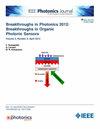The STR Line-of-Sight Pointing and Acquisition in the Gravitational Wave Detection Interstellar Laser Link
IF 2.4
4区 工程技术
Q3 ENGINEERING, ELECTRICAL & ELECTRONIC
引用次数: 0
Abstract
In space gravitational wave detection, the establishment of inter-satellite laser links is a prerequisite for the smooth execution of the detection mission. The TianQin space gravitational wave detection Program uses star tracker (STR) and a charge coupled device (CCD)/ quadrant photodiode (QPD) to complete the construction of a bidirectional satellite laser link to achieve high-precision laser acquisition and tracking control. In order to solve the problem of the initial acquisition uncertainty cone being too large, the coordinate transformation matrix principle is applied to complete the STR line-of-sight calibration, so as to reduce the size of the acquisition uncertainty cone. The probability density distribution function of the uncertainty cone and the size of the uncertainty cone were determined based on the Monte Carlo simulation method. The average scanning acquisition time simulation calculation is completed based on the spiral scanning principle. The simulation results show that the size of the acquisition uncertainty cone after STR line-of-sight calibration is reduced by 73.24% compared with the original acquisition uncertainty cone, and the scanning acquisition time is reduced by 92.8% compared with the original scanning acquisition time.引力波探测星际激光链路中STR视距指向与获取
在空间引力波探测中,星间激光链路的建立是探测任务顺利执行的前提。“天芹”空间引力波探测项目采用星跟踪器(STR)和电荷耦合器件(CCD)/象限光电二极管(QPD)完成双向卫星激光链路建设,实现高精度激光采集和跟踪控制。为了解决初始获取不确定锥过大的问题,应用坐标变换矩阵原理完成STR视距标定,以减小获取不确定锥的尺寸。基于蒙特卡罗模拟方法确定了不确定锥的概率密度分布函数和不确定锥的大小。基于螺旋扫描原理,完成了平均扫描采集时间的仿真计算。仿真结果表明,STR视距标定后的采集不确定锥尺寸比原采集不确定锥减小73.24%,扫描采集时间比原扫描采集时间缩短92.8%。
本文章由计算机程序翻译,如有差异,请以英文原文为准。
求助全文
约1分钟内获得全文
求助全文
来源期刊

IEEE Photonics Journal
ENGINEERING, ELECTRICAL & ELECTRONIC-OPTICS
CiteScore
4.50
自引率
8.30%
发文量
489
审稿时长
1.4 months
期刊介绍:
Breakthroughs in the generation of light and in its control and utilization have given rise to the field of Photonics, a rapidly expanding area of science and technology with major technological and economic impact. Photonics integrates quantum electronics and optics to accelerate progress in the generation of novel photon sources and in their utilization in emerging applications at the micro and nano scales spanning from the far-infrared/THz to the x-ray region of the electromagnetic spectrum. IEEE Photonics Journal is an online-only journal dedicated to the rapid disclosure of top-quality peer-reviewed research at the forefront of all areas of photonics. Contributions addressing issues ranging from fundamental understanding to emerging technologies and applications are within the scope of the Journal. The Journal includes topics in: Photon sources from far infrared to X-rays, Photonics materials and engineered photonic structures, Integrated optics and optoelectronic, Ultrafast, attosecond, high field and short wavelength photonics, Biophotonics, including DNA photonics, Nanophotonics, Magnetophotonics, Fundamentals of light propagation and interaction; nonlinear effects, Optical data storage, Fiber optics and optical communications devices, systems, and technologies, Micro Opto Electro Mechanical Systems (MOEMS), Microwave photonics, Optical Sensors.
 求助内容:
求助内容: 应助结果提醒方式:
应助结果提醒方式:


